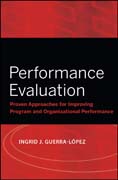
Performance evaluation: proven approaches for improving program and organizational performance
Guerra-Lopez, Ingrid J.
"Performance Evaluation" is a hands-on text for practitioners, researchers, educators, and students in how to use scientifically-based evaluations that areboth rigorous and flexible. Author Ingrid Guerra-Lopez, an internationally-known evaluation expert, introduces the foundations of evaluation and presents the most applicable models for the performance improvement field. Her book offers a wide variety of tools and techniques that have proven successful and is organized to illustrate evaluation in the context of continual performance improvement. INDICE: ForewordSection 1: Introduction to EvaluationChapter 1Introductionto EvaluationKey PointsDecisions, Decisions...A Brief Overview of Evaluation HistoryEvaluation: Purpose and DefinitionPerformance Improvement: A ConceptualFrameworkMaking Evaluation Happen: Ensuring Stakeholders Buy-inThe Evaluator:A job or a role?The Relationship to Other Investigative Processes: Evaluation, Needs Assessment, and Scientific ResearchWhen Does Evaluation Occur?General Evaluation OrientationsChallenges Faced By EvaluatorsEnsuring CommitmentBenefits of EvaluationBasic DefinitionsChapter 2 Principles of Performance-Based EvaluationKey PointsWhat are we seeking?Principle 1: Evaluation-good evaluation-is based on asking the right questionsEvaluation Question StringsDeveloping Questions that Guide Valid and Useful EvaluationPrinciple 2: Evaluation of process (means) is a function of obtained results (ends)Getting Ends and Means Identified and LinkedPrinciple 3: Goals and objectives of organizations should be based on valid needsPrinciple 4: Derive valid needs using a top-down approach: rolling down from external impact and value added to the results and methods used within the organizationPrinciple 5: Every organization should aim for bestthat society can attain. Evaluation standards must be linked to a useful and real strategic visionPrinciple 6: The set of evaluation questions drives the evaluation studySection 2 Models of EvaluationChapter 3 Overview of Existing Evaluation ModeKey PointsOverview of Classic Evaluation ModelsSelected Evaluation ModelsWhich model should you select?Conceptualizing a Useful Evaluation ThatFits Your SituationReflection QuestionsChapter 4 Kirkpatrick's Four Levels ofEvaluationKey PointsOverview of the Model and Relevant ResearchDescription ofKirkpatrick's LevelsCriticisms of the ModelStrengths and limitationsApplication SampleAdditional ApplicationReflection QuestionsChapter 5 Phillips Return on InvestmentKey PointsOverview of the ModelDescription of Phillip's ROI ProcessApplication ExampleAdditional case applicationsReflection QuestionsChapter 6 Brinkerhoff Success Case MethodKey Points103Overview of the ModelDescription of the SCM ProcessConclusionApplication ExampleReflection QuestionsChapter 7 The Impact Evaluation ProcessKey PointsOverview of the ModelA note on the natureof inquiry of the Impact Evaluation ProcessThe Impact Evaluation Process: Seven Aligned and Reiterative StepsConclusionApplication ExampleReflection QuestionsChapter 8 The CIPP ModelKey PointsOverview of the ModelDescription of Stufflebeam's Four Types of EvaluationArticulating Core Values of Programs and SolutionsMethods Used in CIPP EvaluationsApplication ExampleAdditional case applicationsReflection QuestionsChapter 9 Evaluating EvaluationsKey PointsCan we trust Evaluation Findings?Definition of MetaevaluationEvaluation StandardsThe American Evaluation Association Principles for EvaluatorsApplication ExampleReflection QuestionsSection 3 Tools and Techniques of EvaluationChapter 10 DataKey PointsData DefinedCharacteristics of DataDefining Required Data from Performance ObjectivesDeriving Measurable IndicatorsFinding Data SourcesChapter 11 DataCollectionKey PointsIntroduction to Data Collection MethodsObservation Methodology and the Purpose of MeasurementProblems with Classic Experimental Studiesin Applied SettingsTime Series StudiesDocument-Centered MethodsReflection QuestionsChapter 12 Analysis of Evaluation Data: Tools and TechniquesKey pointsMethods of Qualitative AnalysisAnalysis of Models and PatternsAnalysis using Structured DiscussionImposing Structure on Emerging IssuesRelevancyControls on Structured DiscussionMethods of Quantitative AnalysisStatisticsTwo types of statisticsMeasures of Central TendencyMeasures of Dispersion (Variability)Graphical Representations of Data27Measures of RelationshInferential Statistics: Parametric and Non-ParametricInterpretationReflection QuestionsChapter 13 Communicating the FindingsKey PointsRecommendationsConsiderations for Implementing RecommendationsDeveloping the ReportThe Evaluator's Role After the ReportReflection QuestionsSection 4 Continual ImprovementChapter 14 Common Errors in EvaluationErrors of System MappingErrors of LogicErrors of procedureReflection QuestionsChapter 15 Continual ImprovementKey PointsWhat is Continual Improvement?Monitoring PerformanceAdjusting PerformanceThe Role of LeadershipReflection QuestionsChapter 16 Contracting for Evaluation ServicesKey PointsThe Nature of ContractsFixed PriceCost Plus Fixed FeeTime and MaterialsConsulting RetaineContracting ControlsContract ElementsOther Contract ClausesSample Statement of Work (SOW)General InformationContract Award MeetingGeneral RequirementsSpecific Mandatory Tasks and Associated DeliverablesDescription of Tasks and Associated Deliverables:Schedule for DeliverablesChanges to Statement of WorkReporting RequirementsTravel and Site VisitsSellalot Corporation ResponsibilitiesContractor Experience RequirementsConfidentiality and NondisclosureChapter 17 Intelligence Gathering for Decision Making: Performance Measurement SystemsKey PointsMeasures, Intelligence and DecisionsPerformance Measurements SystemsIssues in Performance Measurement SystemsConclusionReflection QuestionsChapter 18 The Future of Evaluation in Performance ImprovementKey PointsIntroductionEvaluation and Measurement in Performance Improvement TodayWhat Does the Future Hold?ConclusionReferences and Related Readings.
- ISBN: 978-0-7879-8883-8
- Editorial: Jossey Bass
- Encuadernacion: Rústica
- Páginas: 320
- Fecha Publicación: 01/05/2008
- Nº Volúmenes: 1
- Idioma: Inglés
